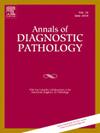Primary intrarenal hemangioma – A series of 39 cases
IF 1.4
4区 医学
Q3 PATHOLOGY
引用次数: 0
Abstract
Intrarenal hemangiomas lack concise clinicopathologic information, due to the predominance of single case reports and inclusion of other vascular neoplasms and hemangiomas of perirenal, hilar, and renal vein origin. Herein, in this multi-institutional study we evaluate clinicopathologic features of 39 intrarenal hemangiomas. The median age was 62 years (range = 27–94 years; 2:1 male to female ratio), with left-sided predominance (left = 21, right = 13; one case was bilateral). The median tumor size was 1.5 cm (0.2-10 cm). Two cases arose from transplanted kidneys. Most were asymptomatic (n = 30, 86 %), even though most surgical interventions (19 partial, 19 radical, 1 biopsy) were due to hemangiomas (n = 24, 62 %). Synchronous renal neoplasms were present in 9 (23 %) patients, including clear cell renal cell carcinoma (RCC) (n = 4), angiomyolipoma (n = 2), oncocytoma (n = 2), and chromophobe RCC (n = 1). Multifocal hemangiomas (n = 5) were seen in cases with end stage renal disease. Intrarenal hemangiomas were mostly anastomosing (n = 18; 46 %), followed by capillary (n = 15; 38 %), and cavernous (n = 6; 16 %) subtypes. Fibrin thrombus (n = 9; 23 %) and extramedullary hematopoiesis (n = 4; 10 %) were occasionally present, the latter being only in the anastomosing subtype. Immunohistochemistry was performed on a majority (n = 33, 84 %) of hemangiomas, with vascular markers CD31 and CD34 and lack of PAX8 were most used for diagnosis. 30 patients had follow-up (median 48 months, range 1–241 months), none showed disease progression/recurrence. This study provides comprehensive observation of the largest intrarenal hemangioma cohort, highlighting their frequent cause of surgical intervention when present, predominance of anastomosing subtype, multifocality in end stage kidney disease, and occasional concurrent ipsilateral neoplasms.
原发性肾内血管瘤——附39例报告。
肾内血管瘤缺乏简明的临床病理资料,主要是单一病例的报道,包括其他血管肿瘤和起源于肾周、肾门和肾静脉的血管瘤。在此,在这项多机构的研究中,我们评估了39例肾内血管瘤的临床病理特征。中位年龄为62岁(范围27-94岁;男女比例2:1),左侧占优势(左= 21,右= 13;一例为双侧)。中位肿瘤大小为1.5 cm (0.2-10 cm)。2例是由肾脏移植引起的。大多数患者无症状(n = 30, 86%),尽管大多数手术干预(19例部分手术,19例根治性手术,1例活检)是由于血管瘤(n = 24, 62%)。9例(23%)患者出现同步肾肿瘤,包括透明细胞肾细胞癌(RCC) (n = 4)、血管平滑肌脂肪瘤(n = 2)、嗜瘤细胞瘤(n = 2)和厌色肾细胞癌(n = 1)。多灶性血管瘤(n = 5)见于终末期肾病患者。肾内血管瘤以吻合性为主(n = 18;46%),其次是毛细管(n = 15;38%)和海绵状窝(n = 6;16%)亚型。纤维蛋白血栓(n = 9;23%)和髓外造血(n = 4;10%)偶尔存在,后者仅存在于吻合亚型。大多数(n = 33, 84%)的血管瘤进行了免疫组化,血管标志物CD31和CD34以及缺乏PAX8是最常用的诊断方法。30例患者随访(中位48个月,范围1-241个月),无疾病进展/复发。本研究对最大的肾内血管瘤队列进行了全面观察,强调了其存在时手术干预的常见原因,吻合亚型的优势,终末期肾脏疾病的多灶性以及偶尔并发的同侧肿瘤。
本文章由计算机程序翻译,如有差异,请以英文原文为准。
求助全文
约1分钟内获得全文
求助全文
来源期刊
CiteScore
3.90
自引率
5.00%
发文量
149
审稿时长
26 days
期刊介绍:
A peer-reviewed journal devoted to the publication of articles dealing with traditional morphologic studies using standard diagnostic techniques and stressing clinicopathological correlations and scientific observation of relevance to the daily practice of pathology. Special features include pathologic-radiologic correlations and pathologic-cytologic correlations.

 求助内容:
求助内容: 应助结果提醒方式:
应助结果提醒方式:


